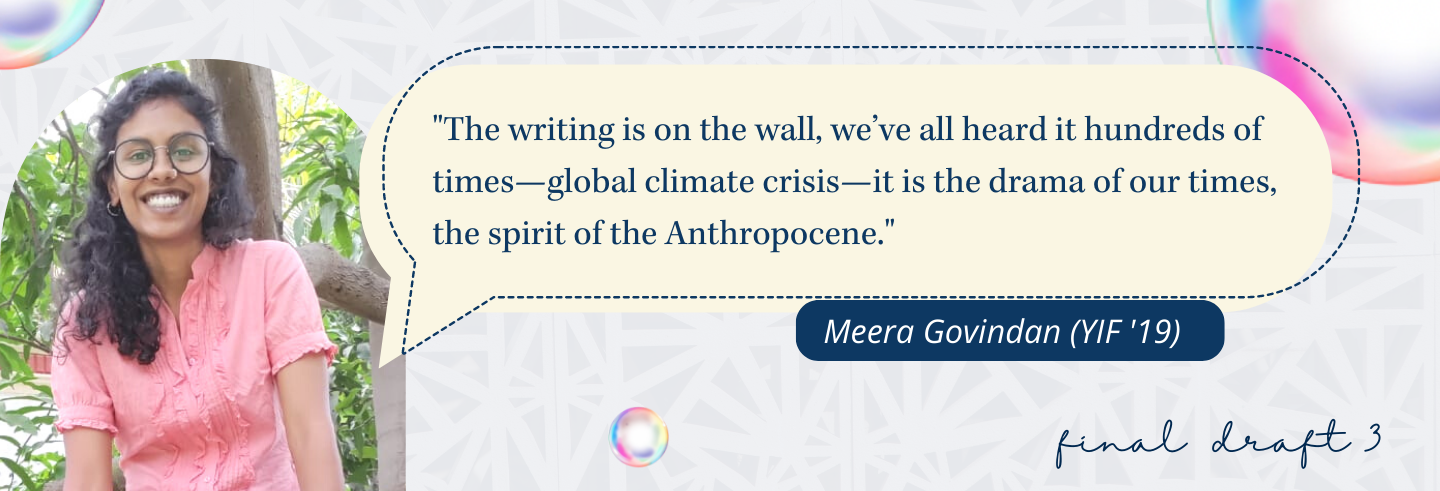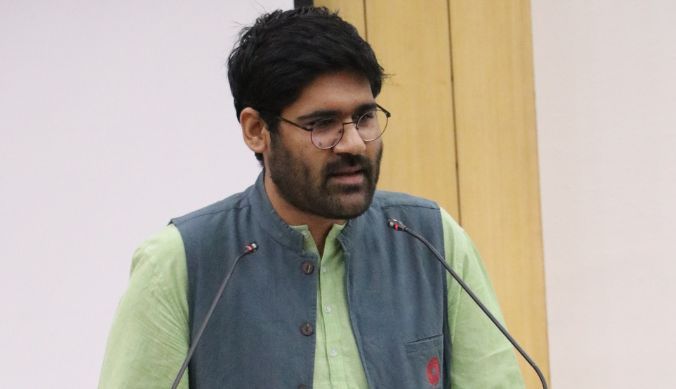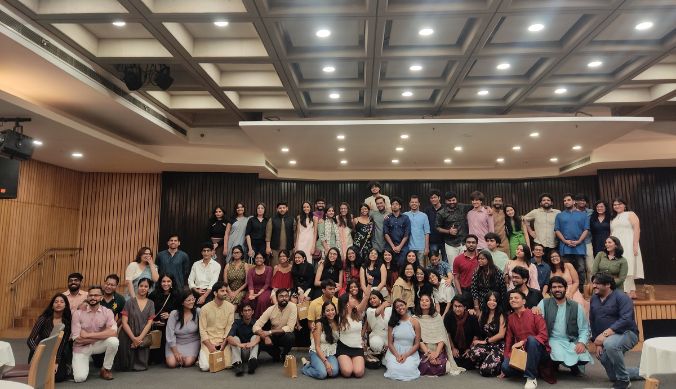‘Walking on Water: Stories of the Anthropocene’
Featuring Meera C. Govindan’s creative piece that developed as an original project over her term at the Young India Fellowship

Meera C Govindan
22 September, 2022 | 6m readAbstract:
Recollecting and reflecting her experience of floods in Chennai, Meera Govindan probes into the politics of representation (or lack thereof) of climate change in contemporary popular culture. Why have literature and films failed to come up with an effective framework to embody the threat of global climate crisis?
Article:
I.
Fewer things are harder to forget than the terror of childhood nightmares, especially the ones seen so often that they almost become a memory. As a kid, I’d dream of a drowning world. A world where there is the din of the ocean and nothing else. There would be no traces of our existence, no buildings, no trees, no continents; just the ocean. Pralaya— the end of the world as we know it, a deluge. Imagine it unfolding in real life, as if something, somewhere made the worst spectres of my dreams come alive.
The first time I saw it up close, I was 11 years old. It was in October 2007. That week recorded the year’s highest rainfall—118.2 mm. My father and I walked 7 kilometres in the monsoon-washed Chennai roads and somehow the water seemed to never end. It felt as though the ocean had made a home in the city; the streets a tattered murky brown Venice. As we walked, the water rose until it reached my thighs. Once the electricity went out, I couldn’t help but wonder about the world underneath the water. A world of plastic bags, bent umbrellas, and pothole creatures. The autorickshaws that remained on the street refused rides, worried about getting stuck in the flood. We got home after midnight, wet to our bones and filthy. Perhaps for the first time in my childhood, I understood nature as something to be feared. The ominous dark skies lasted for a week that felt like a lifetime. For days after the rain, I was haunted by some primitive sadness, as if something bigger awaited us all.
When we talk about ancient civilisations like the Indus Valley that seemingly vanished in the blink of an eye, I think we feel a similar ancient sadness. In those instances, despite our firm belief that life is guided by reason, our history is evidence enough that there is more to our existence than meets the eye. Then why is it that we brush these inklings aside when we have set into motion, knowingly and unknowingly, the unravelling of the planet?
——————————
The writing is on the wall, we’ve all heard it hundreds of times—global climate crisis—it is the drama of our times, the spirit of the Anthropocene. Yet, some deny it altogether, some ignore it, and the rest don’t quite know what to do with it. Climate change deniers often use the rhetoric that climate change is as old as time—since the dawn of the planet, Earth has indeed seen five mass extinction events as a result of or accompanied by climate change. But it is only since the early twenty-first century that the impact of human actions has become so extensive that we are now at the precipice of rapidly altering the very nature of our planet 20 to 50 times faster than ever recorded in its 4.5-billion-year history (Clark et al. 6, 360–69). In effect, being human is killing the planet. We are presiding over a planetary-scale reassortment of species and substantial losses that many refer to as the Earth’s sixth mass extinction event (Oliver). The average abundance of native species in most major land-based habitats has fallen by at least 20 per cent, mostly since 1900. More than 40 per cent of amphibian species, almost 33 percent of reef-forming corals, and more than a third of all marine mammals are threatened. At least 680 vertebrate species have been driven to extinction since the sixteenth century, and more than nine per cent of all domesticated breeds of mammals used for food and agriculture had become extinct by 2016 (Bridgewater et al. 2457–61). The ecological genocide is nowhere close to ending with natural resource extraction and mega infrastructure projects being undertaken by many countries as a part of the development standard required to compete globally. Why is it that despite scientific consensus, no real headway has been made with regard to the climate crisis?
Anyone who’s spent time on the internet in the age of information is aware of climate change—right? One would assume the rise of turmeric lattes, yoga, and organic food would also mean a rising global consciousness of climate change. However, for all the Greta Thunberg-ian activism, and despite the family WhatsApp group forwards about eco-friendly living, we are confronted with the prospect of an uncertain world in our future and a superficial engagement with it at best (O’Neill and Nicholson-Cole 355). Knowledge about climate change and biodiversity loss appears to have little effect on mass consumption patterns that have captured human imagination. While for most of history, human identity was rooted in scarcity, mass consumption has now blurred lines between luxury and necessity. After all, how can a human who is subjected to thousands of hours of advertising every day be expected to change what and how he consumes?
I believe the dissonance between the availability of information and credible action comes down to imagination and storytelling. We see the world not as it exists but as the stories we have about it (Lotto). Stories from recognisable patterns that create meaning. In a way, nothing human could exist without stories, including science and faith. We argue with stories, internally or out loud. We talk back. We praise. We denounce. Every story is the beginning of a conversation, with ourselves as well as with others. If we were to accept that it is primal human nature to understand the world through stories, we could perhaps even say that the global climate crisis is not just an environmental crisis but a cultural one.
One of the problems with the climate crisis story is that of framing. The impact of climate change is often referred to in the context of near time as opposed to deep time—geological time which is unimaginably greater than the time scale of human lives and human plans. While there is a common perception that the climate crisis is a twenty-first-century problem, the scope of it extends from 20 millennia in the past, that is, from the very origin of human civilisation to the next ten millennia when the effect of anthropogenic climate change will grow and persist (Clark et al. 363). What science shows us is that compared to the last major climate change event some 11,700 years ago, anthropogenic climate change has been very rapid, the impact of which may extend to a duration greater than the entire history of human civilisation. Thus, on one hand, we are dealing with the unpredictability of the forces of nature turning against man, and on the other hand, we have the abstraction of this effect over a period of time beyond our wildest imagination, very literally. The unprecedented nature of this crisis also means that human civilisation is now collectively involved in creating stories and myths about a phenomenon that it has never encountered before.
It is unsurprising, therefore, that this has led to the climate crisis being packaged into a doomsday narrative of catastrophe, disarray, and chaos. Popular TV shows and films revolve around end-of-the-world scenarios which require a hero or a group of heroes with great bravery to come and save the day. Sci-fi has been one of the only genres of modern fiction where issues, both human and those that extend beyond the realm of humans, have been addressed with care and creativity. Scifi exemplifies the agency of that which is non-human—artificial intelligence, genetic mutation, superpowers. Thus, perhaps sci-fi is better suited to discuss issues like climate change because it explores the thin line of improbability (Ghosh 20), especially of extreme weather events and so forth. Take the Netflix series The Umbrella Academy, for example. Both seasons of the series are based on the concept that there are ten days left till the end of the world during which the heroes have to save it. Meanwhile, the rest of the world is blissfully unaware that doomsday is around the corner. This is reflective of mass sentiment where drive to collective accountability or action is largely absent. It is also reflective of how crises catch the ordinary unawares.
It is only when the destruction and chaos begin that we pay attention, and by then it is already too late. Sci-fi, because it adopts narratives of heroism, also requires villains. In The Umbrella Academy this comes in the form of the Handler and the Commission, which to any viewer is deeply relatable as the symbol of modern corporatisation. The Commission is a flawed corporate entity which in its attempt to do what it is designed to do, puts an end to the world. Yet, the employees of the Commission are very ordinary and mostly unaware of the part they play. In terms of metaphors, this is probably the best reflection of society as we live in it. The series also reflects an idea that one of my teachers, Prof Dileep Simeon, professor of totalitarian history espouses—the world always feels like it is about to end and men will always be at war with each other, be it the World Wars, space races, nuclear doom or the global climate crisis. Perhaps nobody has paid as much attention to sci-fi as it deserves—as a vehicle of mass sentiments and mass desires.
The doomsday narrative is not exclusive to the sci-fi genre. The scientific community often uses the same vocabulary. The first significant political narrative on climate change, Al Gore’s An Inconvenient Truth1 was also rendered along the same lines. While it propelled public conversation briefly, soon enough the media realised that bad news without any real solutions besides changing light bulbs and reducing plastic usage did not make facing the apocalypse any easier (Smith, Tyszczuk, and Butler 11). The complexity of this idea intensifies once we realise that global warming is a consequence of the global carbon economy whose economic success and positive externalities, including higher living standards, have been driven by fossil fuels. Living standards that we collectively enjoy are at stake. The problem with the doomsday narrative is that we think the world will end in a colossal boom. However, the global climate crisis only serves to highlight that our doomsday may look different—a gradual decline in our standard of living, a planet where death and disease is an everyday occurrence, widespread poverty, a march back into scarcity in the face of the apparent opulence of current times. Perhaps the inability to face this reality is what makes ecological politics a blame game. The United States exiting the Paris Climate Accord, a typical example of this phenomenon, driven by the rhetoric of purported gains and losses, also brings up the question of privilege, retribution, and ideas of development. Though these are too vast to be addressed comprehensively by this paper, it is something we need to think about.
There are two issues at hand while trying to make pro-environment behaviour a part of the mass psyche. The lack of positive engagement with the crisis has to do with fear and our dependence on heroes to save the day. The scientific community with its ‘win-win technical solutions’ such as geoengineering2 does not take into account the ecological genocide and the effect of biodiversity loss. It attempts to prolong the privileges of human behaviour as is. Meanwhile, environmental activists adopt a ‘too little too late’ stance that believes in the end of humanity as we know it. The fear appeal as well as the hero appeal end up being counterproductive. The lack of employing everyday emotions and concerns in the context of this macro-environmental issue does not appeal to the daily office-goer or the parent or the teenager (O’Neill and NicholsonCole 361). The conflict between techno-optimism and eco-pessimism ends up with a ‘you’re either with us or against us’ stance. There is no space for new narratives to evolve within the serious narrative spectrum (Smith, Tyszczuk, and Butler 11).
II.
Chennai is one of those cities where monsoon brings with it a cyclone and/ or flooding every year, so much so that when it starts getting cloudy, people would sit in front of the local channels hoping for a newsflash proclaiming a city-wide holiday. The cyclone would uproot a couple of trees, make water wastelands out of the roads. As candles ran out and the wind howled, it had the potential to make Shelley write Frankenstein.
It was November–December 2015; 1,049 mm; the one that the CAG (Comptroller and Auditor General of India) would later term a ‘man-made disaster’. When the incessant rains and the subsequent flooding was reaching its peak, I was a reporting intern at The Hindu. As I travelled to the office every day, I’d see the Cooum river swell and eat away at the fringes of the Cooum cheri 3 . In the newsroom though, the cyclone was just another story. A small PTI report about the India Meteorological Department predicting more rains appeared in a corner. Scary and foreboding WhatsApp forwards were chalked off to fake news; the meteorological department and Mr Ramanan, the weatherman had always been a joke—well known to predict rain on sunny days and vice versa. Their predictions also lost ground to directly impactful and newsworthy real-world stories. Everyone thought they knew Chennai weather from their past experiences. Floods were nothing unusual, just a little too much rain; it would come and go. Little did we know. This was 1 November. Within a month, for the first time since its founding in 1878, The Hindu would not print their newspaper because of the flood. Close to 250 people died in the flood. Among them was an old couple who lost the keys to their house locked from the inside. As the water rose to their neck, they made a final phone call to their daughter living abroad, an apocalyptic goodbye.
Every story has a beginning, middle, and end. Outside the realm of sci-fi, modern literature has been obsessed with plot lines centred on the ‘everydayness’ of humans—stories begin and end with the human. Telling a story about climate change is then doubly hard. First, because it has to do with subjects far beyond what is just human. Second, because it almost always ends badly for humans. Climate change still seems to be an impersonal and distant issue to many, despite having borne the brunt of it, because they don’t realise their behaviour can be directly related to extreme weather events or other climate phenomena. This gap in cognition is what fiction is tasked with filling up. The easiest way to incorporate non-human elements into a narrative is through metaphor. Yet, even metaphorically, elements of nature slip into the background while the human is considered removed from nature to become the protagonist. Just an Instagram search of #nature is enough to fill your feed with evidence of this: nature in the background for a human’s social media account. Franco Moretti phrases this phenomenon as “the relocation of the unheard of toward the background. … while the everyday moves into the foreground” (Ghosh 23). Further, the human experience of joy, sorrow, conflict, and resolution is removed from the environment it takes place in. For instance, the often-seen lovers in the rain have little to do with rain and more to do with lovers. With climate change, there is a necessity to foreground the phenomenon.
This need arises from the improbability associated with the climate crisis— it will be the first of its kind to ever occur in recorded human history. The highest rainfall, the largest forest fires, the greatest floods, and so on—extreme weather events are very much a part of our day-to-day lives in the Anthropocene. The sheer magnitude of these phenomena is proof enough that man’s conquest over nature has completely and utterly failed. But going back to a period when nature was revered and feared does not help either. Narratives of cultures reflect who we think we are and what we think of ourselves in relation to the world. As cultures appear and disintegrate, so do their narratives. Myths, folklore, and magic realism associated with nature worship predated the western civilisation’s sci-fi. However, even they fall into the trap of fearmongering.
If science has proved beyond doubt that fear doesn’t propel us to our feet, isn’t it time we start thinking about what will?
We now stand at the intersection of clarity and concealment. The stories we create out of this crisis have the same heuristic potential that stories have contained through ages of human history. Therefore, the stories we tell should not be just about the gory and ugly parts of it, but the comedy of it, the tragedy of it, the fear it induces, and the hope it requires to find collective solutions.
Perhaps the narratives of our time are burdened by language. Maybe the priority of dialogue has diminished the value of the metaphor, especially in motion pictures. Take Godfrey Reggio’s 1982 masterpiece Koyaanisqatsi—an experimental film trilogy that explores the way we live. It looks at the intricate relationship between nature, humans, and technology through moving images slowed down, time-lapsed alongside the chants of the word ‘Koyaanisqatsi’, a Hopi Indian word that means a life out of balance. While talking about it he says, “It’s not for lack of love of the language that these films have no words. It’s because, from my point of view, our language is in a state of vast humiliation. It no longer describes the world in which we live.”
The visual medley and transcendental music are not about making perfect sense; there is no linearity of a beginning, middle, and end; nor is there a hero who fights a villain and rides into the sunset. In one of the sequences, footage of a Saturn V rocket lifting off is followed by footage of the May 1962 explosion of an Atlas-Centaur rocket. There are montages where one feels as though one is peering down from the clouds onto barren deserts and sunsets reflected on skyscrapers. It has no story in the formal sense, and yet you can’t peel your eyes away from the narrative it creates, how it can be interpreted from one viewer to another. Cut to the song “Baby” by Four Tet in 2020 or any of the exotic landscapes that form the crux of Cercle concerts in the past two years.
The task of our time is to embody the diverse facets of the crisis we face— not just as an abstract occurrence that happens to someone. Perhaps this requires an appeal to our senses, not just our minds. One of the most interesting creative expressions that arises out of this juncture is the visual representation of climate change and how it could potentially affect people’s perception of the issue. A prime example of this is the internet culture that followed the screening of Planet Earth in April 2019. While often the images of glaciers melting seem like it’s happening on some other planet, hundreds of people broke down sobbing as they watched walruses plummeting to their deaths through their laptop screens. Another projection of the environment exerting its narrative over the human narrative is the phrase winter is coming. This visual and linguistic medley enforces what we already know to be true—life is guided not so much by reason as by the strength of our emotions.
The body of artistic work with regard to climate change has only been expanding and even becoming a part of popular culture. In India this seems to have taken the form of returning to folklore set against a specific geography that also seeps into its culture and polity. Two notable artistic works which have broken boundaries are the films Jallikattu and Karnan. Both evoke the supernatural through what feels like a Marquezian magic realism abundant with metaphors. Both films also brought to mind ideas I remember from Tamil classes as a twelve-year-old; the Dravidian division of landscape by its attributes and local gods—kurinji, the Western Ghats with its flora and fauna; mullai, the riverbanks, fertile and flourishing; marudham, the hillside where Lord Murugan resides; neidhal, the seashores with salt and fish; and paalai, the barren scrubland in the west. In Jallikattu, which was selected as India’s official entry for the Oscars, the metaphor is a wild buffalo causing human-animal conflict, an everyday phenomenon now that their habitats are threatened. Set against the politically laden landscape of the Western Ghats of Kerala, the buffalo thwarts its killers over and over again until the protagonists themselves succumb alongside it in its pursuit. In Karnan, the metaphors are more intertwined with humans—the spirit of a local goddess, a donkey with its legs tied to stop it from running away, the cats, the dogs, the worms and their birds of prey, and a horse all feed into the caste struggle of the scrublands and forests of Tamil Nadu. Here is a film where instead of conflict, the creatures of the landscape form the shape of its politics alongside the humans. It is notable that most of the criticism of the film is centred on the apparent overuse of animals. When one asks, why so many animals? Doesn’t it only prove how disassociated the human experience has become from nature? It is almost as if we have forgotten that this land and everything in it is as much for the cats and the insects as it is for humans. The erasure that accompanies ecocide—the systematic wiping out of ecological systems—can only be combated by the awareness of its existence and our actions against them. The cultural moment is ripe for the rise of a radical ecological democracy tied to art, politics, and the Anthropocene.
The supposed impending doom of the climate crisis would not be the end of the world, not really. It would just be the end of the world as we know it. Not a giant flood that consumes everything living but a world of phenomenally lesser living standards, a world without clean drinking water, a world without the birds and animals we see today. There is evidence enough to suggest that environmental conflicts have often in turn given rise to human conflicts (Diamond 51). A step right back into the old adage of a dog-eat-dog world. Impending doom, only if we let it be. To reimagine such a future requires not just a great scientific heroism but a reimagination of what it means to be human. In such moments that require paradigm shifts, stories always come to the rescue as record keepers, as a heuristic tool. Fiction comes to be reimagined in such a way that it becomes a form of bearing witness, of testifying, and of charting the career of the conscience (Ghosh 167). To shake a world out of balance back to itself within a small window that is rapidly closing, perhaps what we need now more than ever is the very thing that makes us human—art.
III.
As a kid, I’d dream of a drowning world. Perhaps that is why I’ve always felt a calling to the ocean. For three summers I walked the beaches of Chennai after the city had fallen asleep, searching for nesting Olive Ridley turtles while the sea crept up on us silently. Every year, the sea would have eaten a little more into the land. I would think of my dream as I walked on the shorelines. I’ve come to believe that the ocean is as alive as any of us and just as intelligent, perhaps even more so than us. Some days, you could almost taste the intensity of the salt and the thirst. Some days, it would be cold fury and the thundering of waves landing on top of one another. There were days when the ocean was almost crooning lullabies. As a kid when I dreamt of the world drowning, I used to be terrified of the din of the ocean. Now I am learning to listen to her voice. When I dream of the world drowning, it does not end with the drowning. From somewhere high up in the heavens, a kamikaze leaf falls, like a cradle, gently rocking in the air to meet the roaring waters below. And the second they touch, I wake.
About the Author:
Anyone who is a reader inevitably imagines themselves writing. That’s how I started writing. During my undergrad and my early career, I was drawn to performance poetry and the counterculture of Bangalore. Thus, when I arrived at YIF, I thought of writing less as a skill and more as an interest. But the Languages and Realities class shifted writing from the arena of hobby to a necessary tool in interpreting reality. Not only did it help develop a structure and process to writing, but also made it less lonelier. My peer group helped make writing communal and the diversity of our identities made me think deeply about the politics of language. As someone involved in community management and marketing, this has made me very sensitive to the way we tell stories and aspire to tell them better, especially given the dystopian nature of our lives.
About YIF CW Programme:
The YIF Critical Writing programme is a unique, one of a kind opportunity for Fellows to hone their critical thinking and writing skills under the able supervision of trained experts in the field. The CW programme employs a constantly evolving pedagogy, making learning and knowledge production more collaborative and dialogic. Preceptors at the YIF CW programme teach writing through a range of topics including but not limited to ‘History, Philosophy, and Anthropology of Science’, ‘Politics of Language and Multilingualism’, and ‘Education, Literacy, and Justice’.
About Final Draft:
The Final Draft is the annual journal of the YIF Critical Writing programme. It showcases the range in topic and genre, as well as the strength of writing in the highly diverse YIF student body. These pieces of writing, submitted by Fellows from various classes of the YIF represent only a small fraction of the variety and range of writing done over the years.
About our campaign:
Through our ‘Final Draft 3’ campaign, we hope to give you a glimpse into some of the styles and voices that have evolved, the concerns and ideas that fellows have explored, and the seriousness of their engagement with writing as drafts in motion; searching for meaning and connection, which makes this more of a pedagogic exercise book.
(This was first published in the Final Draft, A Journal of the YIF Critical Writing Programme.)













